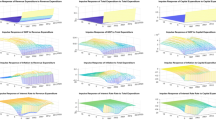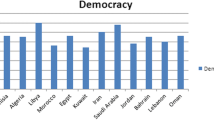Abstract
Here we argue for the use of cointegration and error correction analysis to combine economic factors that are nonstationary with political factors that are stationary into an empirical model of the evolution of public policy over long periods. The approach is applied to disentangle the contributions of economics and politics to the evolution of public expenditure by the Government of Canada over 130 years. Political competition emerges as the primary political factor affecting government size.
Similar content being viewed by others
References
Adams, J., Merrill, S., & Grofman, B. (2005). A unified theory of party competition. Cambridge University Press: New York.
Alesina, A., Roubini, N., & Cohen, G. D. (1997). Political business cycles and the macroeconomy. Cambridge: MIT Press.
Beck, M. J. (1968). Pendulum of power. Scarborough: Prentice-Hall of Canada.
Besley, T., Persson, T., & Sturm, D. (2005). Political competition and economic performance: Theory and evidence from the United States. London School of Economics (unpublished).
Bird, R. (1970). The growth of government spending in Canada. Toronto: Canadian Tax Foundation.
Borcherding, T. E. (1985). The causes of government expenditure growth: A survey of U.S. evidence. Journal of Public Economics, 28, 359–382.
Borcherding, T. E., Ferris, J. S., & Garzoni, A. (2004). Changes in the real size of government since 1970. In J. Backhaus & R. Wagner (Eds.), Kluwer handbook in public finance (pp. 77–108). New York: Kluwer Academic.
Breton, A. (1996). Competitive governments: An economic theory of politics and public finance. New York: Cambridge University Press.
Cameron, D. (1978). The expansion of the public economy. American Political Science Review, 72, 1243–1261.
Canadian Economic Observer (1986). Historical statistical supplement 1986. Ottawa: Statistics Canada Catalogue (pp. 11–210).
Cavaliere, G. (2005). Limited time series with a unit root. Econometric Theory, 21, 907–945.
Coughlin, P. (1992). Probabilistic voting theory. New York: Cambridge University Press.
Cox, G., & Munger, M. C. (1989). Contributions, expenditure, turnout: The 1982 U.S. House elections. American Political Science Review, 83, 217–231.
Drazen, A. (2001). The political business cycle after 25 years. In B. Bernanke & K. Rogoff (Eds.), NBER macroeconomics annual 2000 (pp. 75–117). Cambridge: MIT Press.
Dudley, L., & Witt, U. (2004). Arms and the man: World War I and the rise of the welfare state. Kyklos, 57, 475–504.
Elections Canada Online at http://www.elections.ca.
Endersby, J., Galatas, S., & Rackaway, C. (2002). Closeness counts in Canada: Voter participation in the 1993 and 1997 federal elections. Journal of Politics, 64, 610–631.
Engle, R. F., & Granger, C. W. J. (1987). Co-integration and error correction: Representation, estimation, and testing. Econometrica, 55, 251–276.
Ferris, J. S., & West, E. G. (1996). Testing theories of real government size: US experience, 1959–1989. Southern Economic Journal, 62, 537–553.
Ferris, J. S., & Winer, S. L. (2007). Just how much bigger is government in Canada: A comparative analysis of the size and structure of the public sectors in Canada and the United States, 1929–2003. Canadian Public Policy, 33, 173–206.
Ferris, J. S., Park, S. B., & Winer, S. L. (2006). Political competition and convergence to fundamentals: with application to the political business cycle and the size of government. CESifo working paper No. 1646. Also at www.ssrn.com.
Filer, J. E., & Kenny, L. (1980). Voter turnout and the benefits of voting. Public Choice, 35, 575–585.
Firestone, O. J. (1958). Canada’s economic development 1867–1953. London: Bowes & Bowes.
Flanagan, K. M., & Miller, J. (1992). Canadian parliamentary guide. Toronto: Globe and Mail.
Franklin, M. (2004). Voter turnout and the dynamics of electoral competition in established democracies since 1945. New York: Cambridge University Press.
Gillespie, W. I. (1991). Carleton library series: Vol. 170. Tax, borrow and spend: Financing federal spending in Canada, 1867–1990. Ottawa: Carleton University Press.
Gregory, A. W., & Hansen, B. E. (1996). Residual-based tests for cointegration in models with regime shifts. Journal of Econometrics, 70, 99–126.
Hamilton, J. D. (1994). Time series analysis. Princeton: Princeton University Press.
Hansen, H., & Juselius, K. (1995). Cats in rats: Cointegration analysis of time series. Copenhagen: Institute of Economicsm, University of Copenhagen.
Haynes, S. E., & Stone, J. A. (1990). Political models of the business cycle should be revived. Economic Inquiry, 28, 442–465.
Heckelman, J. C. (2002). Electoral uncertainty and the macroeconomy: The evidence from Canada. Public Choice, 113, 179–189.
Hettich, W., & Winer, S. L. (1999). Democratic choice and taxation. New York: Cambridge University Press.
Hibbs, D. (1977). Political parties and macroeconomic policy. American Political Science Review, 71, 1467–1487.
Johansen, S. (1995). Likelihood-based interance in cointegrated vector autoregressive models. Oxford: Oxford University Press.
Kau, J. B., & Rubin, P. H. (1981). The size of government. Public Choice, 37, 261–274.
Kneebone, R. D., & McKenzie, K. J. (1999). Past (in)discretions: Canadian federal and provincial fiscal policy. Toronto: University of Toronto Press.
Kneebone, R. D., & McKenzie, K. J. (2001). Electoral and partisan cycles in fiscal policy: An examination of Canadian provinces. International Tax and Public Finance, 8, 753–774.
Kontopolous, Y., & Perotti, R. (1999). Government fragmentation and fiscal policy outcomes: Evidence from OECD countries. In J. Poterba & J. von Hagen (Eds.), Fiscal institutions and fiscal performance (pp. 81–102). Chicago: University of Chicago Press.
Leacy, F. H., Urquhart, M. C., & Buckley, K. A. H. (1983). Historical statistics of Canada. Ottawa: Supply and Services Canada.
Legrenzi, G. (2004). The displacement effect in the growth of governments. Public Choice, 120, 191–204.
Levitt, S. D., & Poterba, J. M. (1999). Congressional distributive politics and state economic performance. Public Choice, 99, 185–215.
MacKinnon, J. G. (1996). Numerical distribution functions for unit root and cointegration tests. Journal of Applied Econometrics, 11, 601–618.
Mayhew, D. R. (1974). Congressional elections: The case of the vanishing marginals. Polity, 6, 295–317.
Mink, M., & de Haan, J. (2005). Has the stability and growth pact impeded political budget cycles in the European Union? Cesifo working paper 1532.
Myrdal, G. (1960). Beyond the welfare state. New Haven: Yale University Press.
Mueller, D. C. (2003). Public choice III. New York: Cambridge University Press.
Nordhaus, W. (1975). The political business cycle. Review of Economic Studies, 42, 169–190.
Parliament of Canada. Official web site at http://www.parl.gc.ca/common/index.asp.
Peacock, A., & Wiseman, J. (1961). The growth of public expenditure in the United Kingdom. Princeton: Princeton University Press.
Persson, T., Roland, G., & Tabellini, G. (2004). How do electoral rules shape party structures, government coalitions, and economic policies. CESifo working paper No. 1115.
Public Accounts of Canada (1996–1997). Ottawa: Supply and Services Canada.
Reid, B. (1998). Endogenous elections, electoral budget cycles and Canadian provincial governments. Public Choice, 97, 35–48.
Remmer, K. L., & Wibbels, E. (2000). The subnational politics of economic adjustment. Comparative Political Studies, 33, 419–451.
Rodrik, D. (1998). Why do more open economies have bigger governments?. Journal of Political Economy, 106, 997–1032.
Rogoff, K., & Sibert, A. (1988). Elections and macroeconomic policy cycles. Review of Economic Studies, 91, 1–16.
Rowell-Sirois Commission (1940). Report of the Royal Commission on dominion-provincial relations. Ottawa: The King’s Printer.
Saikkonen, P. (1991). Asymptotically efficient estimation of cointegration regressions. Econometric Theory, 7, 1–21.
Schofield, N., & Sened, I. (2006). Multiparty democracy: Elections and legislative politics. New York: Cambridge University Press.
Serletis, A., & Afxentiou, P. C. (1998). Electoral and partisan cycle regularities in Canada. Canadian Journal of Economics, 31, 28–46.
Shi, M., & Svensson, J. (2006). Political budget cycles: Do they differ across countries and why? Journal of Public Economics, 90, 1367–1389.
Shiller, R. J., & Perron, P. (1985). Testing the random walk hypothesis: Power versus frequency of observation. NBER technical working paper 045.
Solé-Ollé, A. (2006). The effects of party competition on budget outcomes: Empirical evidence from local governments in Spain. Public Choice, 126, 145–176.
Stigler, G. J. (1972). Economic competition and political competition. Pubic Choice, 13, 91–106.
Tellier, G. (2006). Public expenditures in Canadian provinces: An empirical study of politico-economic interactions. Public Choice, 126, 367–385.
Urquhart, M. C. (1965). Historical statistics of Canada. Toronto: Cambridge University Press.
Urquhart, M. C. (1993). Gross national product 1870–1926, the derivation of the estimate. Kingston: McGill-Queens University Press.
Weingast, B., Shepsle, K., & Johnsen, C. (1981). The political economy of benefits and costs: A neoclassical approach to distributive politics. Journal of Political Economy, 89, 642–664.
Wittman, D. (1995). The myth of democratic failure: Why political institutions are efficient. Chicago: University of Chicago Press.
Winer, S. L. (1986). Money and politics in a small open economy. Public Chioce, 51, 221–239.
Winer, S. L., & Ferris, J. S. (2008). Searching for Keynesianism. European Journal of Political Economy, 24, 294–316.
Zhou, S. (2001). The power of cointegration tests versus data frequency and time spans. Southern Economic Journal, 67, 906–921.
Author information
Authors and Affiliations
Corresponding author
Rights and permissions
About this article
Cite this article
Ferris, J.S., Park, SB. & Winer, S.L. Studying the role of political competition in the evolution of government size over long horizons. Public Choice 137, 369–401 (2008). https://doi.org/10.1007/s11127-008-9334-6
Received:
Accepted:
Published:
Issue Date:
DOI: https://doi.org/10.1007/s11127-008-9334-6
Keywords
- Political competition
- Conditional convergence
- Cointegration
- Public expenditure
- Size of government
- Politics versus economics




